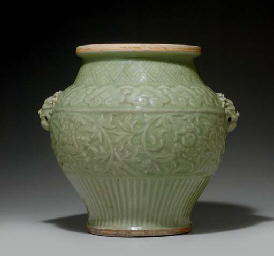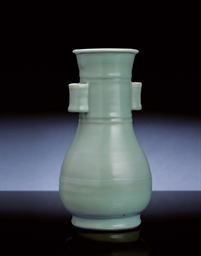A RARE LARGE LONGQUAN CELADON-GLAZED 'DRAGON' DISHYuan Dynasty
Robustly potted with rounded sides rising to an everted rim, the centre of the well applied with a writhing dragon pursuing the flaming pearl, all within a band of large, freely incised leaves, the exterior moulded and incised with a band of upright lotus petals, covered overall in an unctuous sea-green glaze save for a ring at the base partially burnt orange during firing. 35.5cm (14in) diam.Footnotes元 龍泉青釉刻花貼龍紋折沿大盤
Provenance: W.E.A. de Graaf
來源:W.E.A. de Graaf
de Graaf was commemorated by the Dutch government for his resistance activities during WWII. He was the personal assistance of Fritz Philips, head of the electronics company, and was gifted this dish on his retirement.
The present dish is remarkable for its crisp and elegant floral decoration, which emerges under an attractive green glaze which accentuates the harmonious shape.
Spreading over Zhejiang Province into the neighbouring province of Fujian, the Longquan kilns were conveniently located to reach the trade ports of Wenzhou and Quanzhou, from where merchandise could be shipped to foreign markets in the Far East, India, Southeast Asia, the Middle East and even Africa. This advantage was fully exploited in the Yuan and early Ming dynasty and large quantities of wares were made for foreign markets.
Longquan celadon-glazed wares with moulded and applied decoration first appeared in the late Southern Song dynasty and were produced in larger quantities during the Yuan dynasty. Compare a nearly identical Longquan celadon-glazed 'dragon' dish, Yuan dynasty, illustrated in Chinese Celadons and Other Related Wares in Southeast Asia, Singapore, 1979, p.204, pl.132. Another similar dish is in the collection of the Topkapi Saray Museum, Istanbul, illustrated by R.Krahl, Chinese Ceramics in the Topkapi Saray Museum, Istanbul, vol.1, London, 1986, p.256, no.61.
Two very similar Longquan celadon-glazed 'dragon' dishes, Yuan dynasty, were sold at Sotheby's London, 4 November 2021, lot 336, and Christie's New York, 23 September 2022, lot 957.
A RARE LARGE LONGQUAN CELADON-GLAZED 'DRAGON' DISHYuan Dynasty
Robustly potted with rounded sides rising to an everted rim, the centre of the well applied with a writhing dragon pursuing the flaming pearl, all within a band of large, freely incised leaves, the exterior moulded and incised with a band of upright lotus petals, covered overall in an unctuous sea-green glaze save for a ring at the base partially burnt orange during firing. 35.5cm (14in) diam.Footnotes元 龍泉青釉刻花貼龍紋折沿大盤
Provenance: W.E.A. de Graaf
來源:W.E.A. de Graaf
de Graaf was commemorated by the Dutch government for his resistance activities during WWII. He was the personal assistance of Fritz Philips, head of the electronics company, and was gifted this dish on his retirement.
The present dish is remarkable for its crisp and elegant floral decoration, which emerges under an attractive green glaze which accentuates the harmonious shape.
Spreading over Zhejiang Province into the neighbouring province of Fujian, the Longquan kilns were conveniently located to reach the trade ports of Wenzhou and Quanzhou, from where merchandise could be shipped to foreign markets in the Far East, India, Southeast Asia, the Middle East and even Africa. This advantage was fully exploited in the Yuan and early Ming dynasty and large quantities of wares were made for foreign markets.
Longquan celadon-glazed wares with moulded and applied decoration first appeared in the late Southern Song dynasty and were produced in larger quantities during the Yuan dynasty. Compare a nearly identical Longquan celadon-glazed 'dragon' dish, Yuan dynasty, illustrated in Chinese Celadons and Other Related Wares in Southeast Asia, Singapore, 1979, p.204, pl.132. Another similar dish is in the collection of the Topkapi Saray Museum, Istanbul, illustrated by R.Krahl, Chinese Ceramics in the Topkapi Saray Museum, Istanbul, vol.1, London, 1986, p.256, no.61.
Two very similar Longquan celadon-glazed 'dragon' dishes, Yuan dynasty, were sold at Sotheby's London, 4 November 2021, lot 336, and Christie's New York, 23 September 2022, lot 957.



.jpg)





.jpg?w=400?width=1600&quality=70)


.jpg)
.jpg?height=400)
.jpg)
Try LotSearch and its premium features for 7 days - without any costs!
Be notified automatically about new items in upcoming auctions.
Create an alert